高考英语新题型“概要写作”之议论文定稿
- 格式:ppt
- 大小:4.94 MB
- 文档页数:44
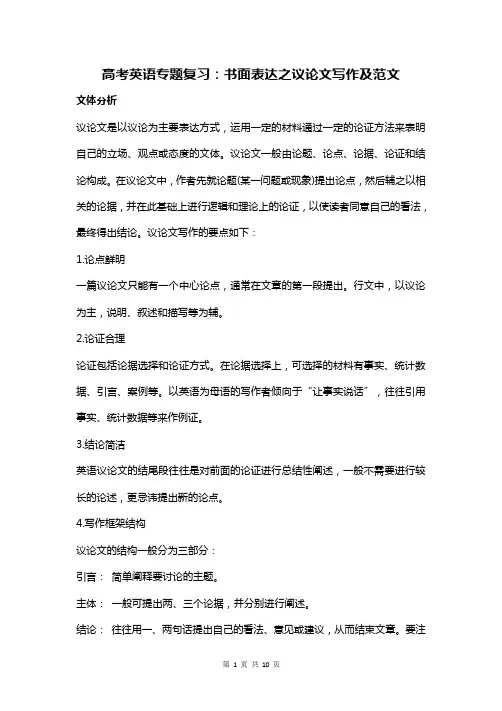
高考英语专题复习:书面表达之议论文写作及范文文体分析议论文是以议论为主要表达方式,运用一定的材料通过一定的论证方法来表明自己的立场、观点或态度的文体。
议论文一般由论题、论点、论据、论证和结论构成。
在议论文中,作者先就论题(某一问题或现象)提出论点,然后辅之以相关的论据,并在此基础上进行逻辑和理论上的论证,以使读者同意自己的看法,最终得出结论。
议论文写作的要点如下:1.论点鲜明一篇议论文只能有一个中心论点,通常在文章的第一段提出。
行文中,以议论为主,说明、叙述和描写等为辅。
2.论证合理论证包括论据选择和论证方式。
在论据选择上,可选择的材料有事实、统计数据、引言、案例等。
以英语为母语的写作者倾向于“让事实说话”,往往引用事实、统计数据等来作例证。
3.结论简洁英语议论文的结尾段往往是对前面的论证进行总结性阐述,一般不需要进行较长的论述,更忌讳提出新的论点。
4.写作框架结构议论文的结构一般分为三部分:引言:简单阐释要讨论的主题。
主体:一般可提出两、三个论据,并分别进行阐述。
结论:往往用一、两句话提出自己的看法、意见或建议,从而结束文章。
要注意与引言段呼应,但不能照搬前面的原话。
5.文章的展开要注意段落间的有机联系一般来说,议论文每段应有主题句来确定观点,让人一目了然。
行文中适当地运用过渡句可以表现出文章的逻辑性。
6.常用句式(1) 引言段①Many students have been faced with the problem of...②Recently the problem has been brought into focus.③Recently the phenomenon has become a heated topic.④Recently the issue has aroused a great concern among...⑤Nowadays there is a growing concern over...⑥Faced with…,quite a few people argue that…⑦According to a recent survey,…⑧With the rapid development of economy/society…,⑨Recently we held/have held a discussion about whether…⑩When it comes to…,…(2) 主体段①As is known to all, …play(s) an important part/role in our daily life/modern society. However, different people have different opinions…②Some people/The majority of the students think it (is) a good idea/important/useful/convenient for…to do…③Others argue/claim that the opposite is true.④However, as every coin has two sides, …also has its disadvantages.(3) 结论段①There is probably some truth in both arguments/statements, but…②From what has been discussed above, we can draw the conclusion that…③It is high time that we took measures to…/We'd better take effective measures to prevent…④It is necessary that steps should be taken to…⑤In conclusion, it is important that…⑥To solve the abovementioned problem(s), we must…⑦In summary, if we continue to ignore the issue, more problems will come up.⑧Taking all these into account, we…7. 常用写作模板【模板一】利弊对比型Nowadays, there is a widespread concern over (the issue that) ____________ (论题). In fact, there are both advantages and disadvantages in ____________ (论题). Generally speaking, it is widely believed that there are several positive aspects as follows. Firstly, ____________ (优点一). Secondly, ____________ (优点二).Just as a popular saying goes, “Every coin has two sides.”____________ (论题) is no exception, and in other words, it still has negative aspects. To。
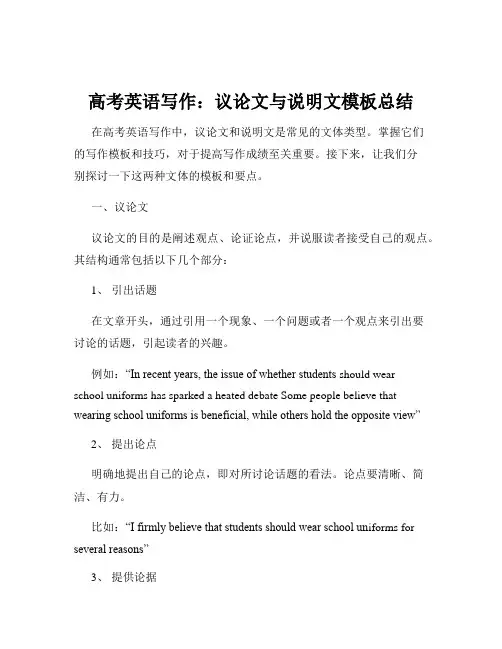
高考英语写作:议论文与说明文模板总结在高考英语写作中,议论文和说明文是常见的文体类型。
掌握它们的写作模板和技巧,对于提高写作成绩至关重要。
接下来,让我们分别探讨一下这两种文体的模板和要点。
一、议论文议论文的目的是阐述观点、论证论点,并说服读者接受自己的观点。
其结构通常包括以下几个部分:1、引出话题在文章开头,通过引用一个现象、一个问题或者一个观点来引出要讨论的话题,引起读者的兴趣。
例如:“In recent years, the issue of whether students should wearschool uniforms has sparked a heated debate Some people believe that wearing school uniforms is beneficial, while others hold the opposite view”2、提出论点明确地提出自己的论点,即对所讨论话题的看法。
论点要清晰、简洁、有力。
比如:“I firmly believe that students should wear school un iforms for several reasons”3、提供论据运用具体的例子、事实、数据等来支持自己的论点,增强文章的说服力。
例如:“Firstly, wearing school uniforms helps to create a sense of unity and equality among students When everyone is dressed the same, it reduces the pressure of competition based on appearance and wealth For instance, in School A, where uniforms are mandatory, students reported feeling less judged by their clothing and more focused on their studies”“Secondly, school uniforms save time and effort for students in the morning Instead of spending precious minutes deciding what to wear, they can concentrate on preparing for the day ahead A survey conducted in School B showed that students who wore uniforms spent an average of 20 minutes less on getting dressed in the morning, allowing them to have a more relaxed start to the day”4、反驳对立观点预见可能存在的反对意见,并进行有理有据的反驳,进一步巩固自己的论点。
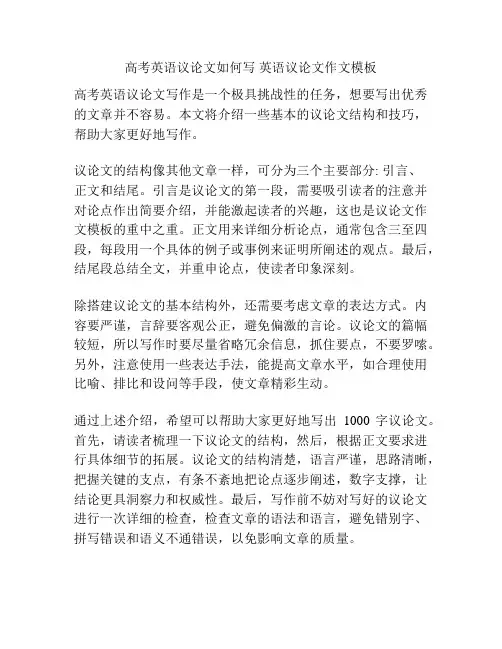
高考英语议论文如何写英语议论文作文模板
高考英语议论文写作是一个极具挑战性的任务,想要写出优秀的文章并不容易。
本文将介绍一些基本的议论文结构和技巧,帮助大家更好地写作。
议论文的结构像其他文章一样,可分为三个主要部分: 引言、
正文和结尾。
引言是议论文的第一段,需要吸引读者的注意并对论点作出简要介绍,并能激起读者的兴趣,这也是议论文作文模板的重中之重。
正文用来详细分析论点,通常包含三至四段,每段用一个具体的例子或事例来证明所阐述的观点。
最后,结尾段总结全文,并重申论点,使读者印象深刻。
除搭建议论文的基本结构外,还需要考虑文章的表达方式。
内容要严谨,言辞要客观公正,避免偏激的言论。
议论文的篇幅较短,所以写作时要尽量省略冗余信息,抓住要点,不要罗嗦。
另外,注意使用一些表达手法,能提高文章水平,如合理使用比喻、排比和设问等手段,使文章精彩生动。
通过上述介绍,希望可以帮助大家更好地写出1000字议论文。
首先,请读者梳理一下议论文的结构,然后,根据正文要求进行具体细节的拓展。
议论文的结构清楚,语言严谨,思路清晰,把握关键的支点,有条不紊地把论点逐步阐述,数字支撑,让结论更具洞察力和权威性。
最后,写作前不妨对写好的议论文进行一次详细的检查,检查文章的语法和语言,避免错别字、拼写错误和语义不通错误,以免影响文章的质量。
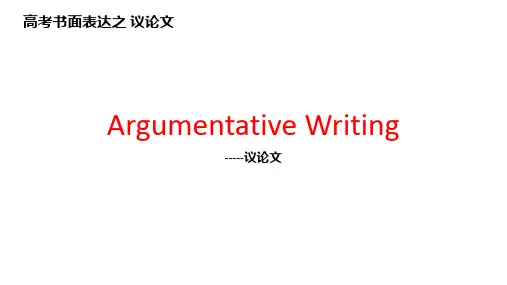
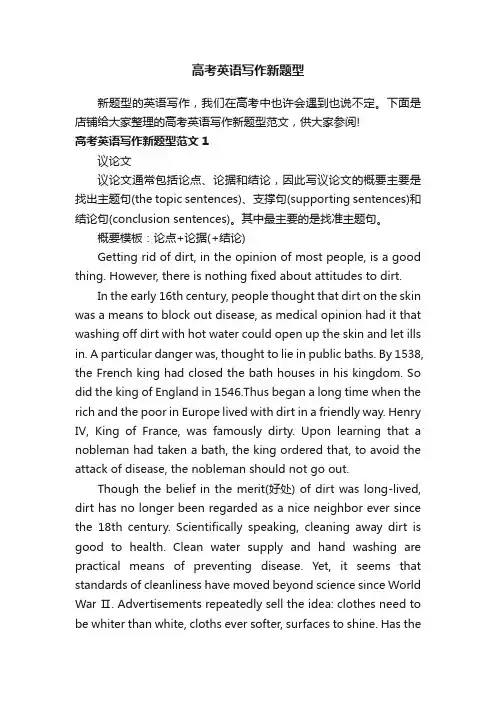
高考英语写作新题型新题型的英语写作,我们在高考中也许会遇到也说不定。
下面是店铺给大家整理的高考英语写作新题型范文,供大家参阅!高考英语写作新题型范文1议论文议论文通常包括论点、论据和结论,因此写议论文的概要主要是找出主题句(the topic sentences)、支撑句(supporting sentences)和结论句(conclusion sentences)。
其中最主要的是找准主题句。
概要模板:论点+论据(+结论)Getting rid of dirt, in the opinion of most people, is a good thing. However, there is nothing fixed about attitudes to dirt.In the early 16th century, people thought that dirt on the skin was a means to block out disease, as medical opinion had it that washing off dirt with hot water could open up the skin and let ills in. A particular danger was, thought to lie in public baths. By 1538, the French king had closed the bath houses in his kingdom. So did the king of England in 1546.Thus began a long time when the rich and the poor in Europe lived with dirt in a friendly way. Henry Ⅳ, King of France, was famously dirty. Upon learning that a nobleman had taken a bath, the king ordered that, to avoid the attack of disease, the nobleman should not go out.Though the belief in the merit(好处) of dirt was long-lived, dirt has no longer been regarded as a nice neighbor ever since the 18th century. Scientifically speaking, cleaning away dirt is good to health. Clean water supply and hand washing are practical means of preventing disease. Yet, it seems that standards of cleanliness have moved beyond science since World War Ⅱ. Advertisements repeatedly sell the idea: clothes need to be whiter than white, cloths ever softer, surfaces to shine. Has thehate for dirt, however, gone too far?Attitudes to dirt still differ hugely nowadays. Many first time parents nervously try to warn their children off touching dirt, which might be responsible for the spread of disease. On the contrary, Mary Ruebush, an American immunologist (免疫学家), encourages children to play in the dirt to build up a strong immune system(免疫系统). And the latter position is gaining some ground. (302 words)高考英语写作新题型范文2阅读下面短文,根据内容写一篇60词左右的内容概要。
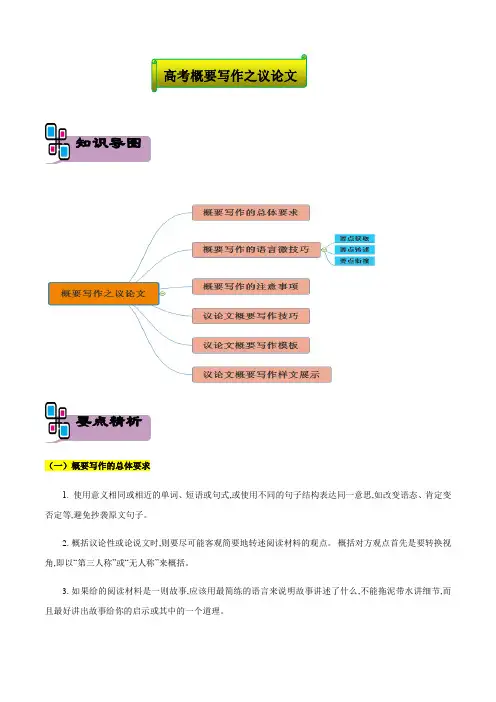
高考概要写作之议论文知识导图要点精析(一)概要写作的总体要求1. 使用意义相同或相近的单词、短语或句式,或使用不同的句子结构表达同一意思,如改变语态、肯定变否定等,避免抄袭原文句子。
2.概括议论性或论说文时,则要尽可能客观简要地转述阅读材料的观点。
概括对方观点首先是要转换视角,即以“第三人称”或“无人称”来概括。
3.如果给的阅读材料是一则故事,应该用最简练的语言来说明故事讲述了什么,不能拖泥带水讲细节,而且最好讲出故事给你的启示或其中的一个道理。
4.如果是说明性或描述性的短文,就必须用概括性的文字说明一个现象。
(二)概要写作的语言微技巧1. 要点获取。
要点获取过程就是文本解读过程。
对于结构比较清楚的段落,可以通过筛选、寻找主题句找到要点,这通常是指能够概括全文或段落的关键句子;对于主题句不明确的文章或段落,可以使用关键词来设计主题句的方法。
2.要点转述。
要求使用自己的语言来进行自主表述。
可以从以下几个主要方面进行转述:(1)同义替容自若,就能化复杂句式为简单句或整合重组松散句子。
3.要点衔接。
概要写作并不是简单的要点罗列与堆砌,因此,在获取要点和转述要点之后,应特别关注各要点之间内部联系和逻辑结构,用适当的衔接将要点进行连接,从而形成一篇结构紧凑的小小短文。
写作中常见的衔接词如下:1)对立关系包括让步和转折关系,常见的标志词和短语:but, however, yet, on the contrary, by contrast, unfortunately, although, even though, nevertheless, in spite of, regardless of, anyhow, instead of, rather than, not…but等。
2)因果关系常用的标志词和短语有:because, for, since, as, thus, hence, therefore, so, so…that, such…that, in order that, consequently, accordingly, due to, thanks to, in response to, on account of, because of, considering that, seeing that, in that, now that, as a result, for this reason等。
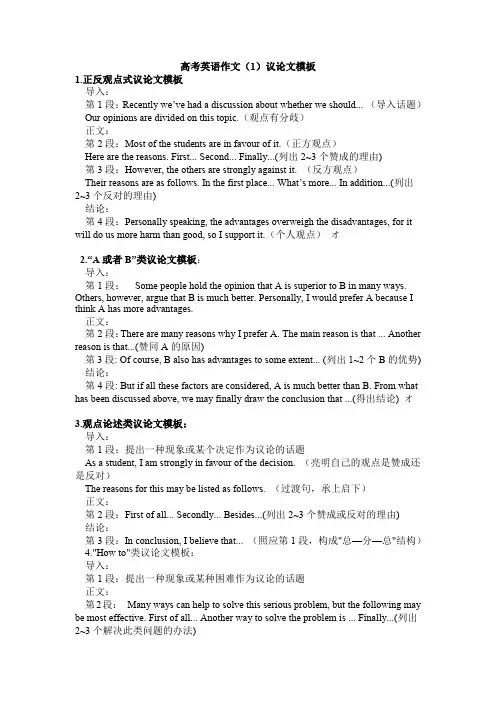
高考英语作文(1)议论文模板1.正反观点式议论文模板导入:第1段:Recently we’ve had a discussion about whether we should... (导入话题)Our opinions are divided on this topic.(观点有分歧)正文:第2段:Most of the students are in favour of it.(正方观点)Here are the reasons. First... Second... Finally...(列出2~3个赞成的理由)第3段:However, the others are strongly against it. (反方观点)Their reasons are as follows. In the first place... What’s more... In addition...(列出2~3个反对的理由)结论:第4段:Personally speaking, the advantages overweigh the disadvantages, for it will do us more harm than good, so I support it.(个人观点)オ2.“A或者B”类议论文模板:导入:第1段:Some people hold the opinion that A is superior to B in many ways. Others, however, argue that B is much better. Personally, I would prefer A because I think A has more advantages.正文:第2段:There are many reasons why I prefer A. The main reason is that ... Another reason is that...(赞同A的原因)第3段: Of course, B also has advantages to some extent... (列出1~2个B的优势) 结论:第4段: But if all these factors are considered, A is much better than B. From what has been discussed above, we may finally draw the conclusion that ...(得出结论) オ3.观点论述类议论文模板:导入:第1段:提出一种现象或某个决定作为议论的话题As a student, I am strongly in favour of the decision. (亮明自己的观点是赞成还是反对)The reasons for this may be listed as follows. (过渡句,承上启下)正文:第2段:First of all... Secondly... Besides...(列出2~3个赞成或反对的理由)结论:第3段:In conclusion, I believe that... (照应第1段,构成"总—分—总"结构)4."How to"类议论文模板:导入:第1段:提出一种现象或某种困难作为议论的话题正文:第2段:Many ways can help to solve this serious problem, but the following may be most effective. First of all... Another way to solve the problem is ... Finally...(列出2~3个解决此类问题的办法)结论:第3段:These are not the best but the only two/ three measures we can take. But it should be noted that we should take action to...(强调解决此类问题的根本方法)(附):巧用连接词要想使文章有整体性、连贯性,就要学会正确使用连接词表示罗列增加First, second, third,First, then / next, after that / next, finallyFor one thing … for another…,On (the) one hand…o n the other hand,Besides / what’s more / in addition / furthermore / moreover / another / also,Especially / In particular,表示时间顺序now, at present, recently,after, afterwards, after that, after a while, in a few days,at first, in the beginning, to begin with,later, next, finally,immediately, soon, suddenly, all of a sudden, at that moment, as soon as, the momentform now on, from then on,at the same time, meanwhile,till, not…until, bef ore, after, when, while, as during,表示解释说明now, in addition, for example, for instance, in this case, moreoverfurthermore, in fact, actually表示转折关系but, however, while, though, or, otherwise, on the contrary, on the otherhand, in contrast, despite, in spite of, even though, except (for), instead, of course, after all,表示并列关系or, and, also, too, not only … but also, as well as, both… and, either …or, neither …nor表示因果关系because, because of, since, now that, as, thanks to…, due to…, therefore, as a result (of), otherwise, so…that, such…that表示条件关系as (so) long as, on condition that, if, unless表示让步关系though, although, as, even if, even though, whether …or…, however, whoever, whatever, whichever, wherever, whenever, no matter how (who, what, which, where, when, whom)表示举例for example, for instance, such as…, take… for example表示比较be similar to, similarly, the same as, in contrast, compared with (to)…just like, just as,表示目的for this reason,, for this purpose, so that, in order to, so as to,表示强调in deed, in fact, surely, certainly, no doubt, without any doubt, truly, obviously, above all,表示概括归纳in a word, in short, in brief, on the whole, generally speaking, in my opinion, as far as I know, As we all know, as has been stated, as I have shown, finally, at last, insummary, in conclusion,赠送以下资料考试知识点技巧大全一、考试中途应饮葡萄糖水大脑是记忆的场所,脑中有数亿个神经细胞在不停地进行着繁重的活动,大脑细胞活动需要大量能量。
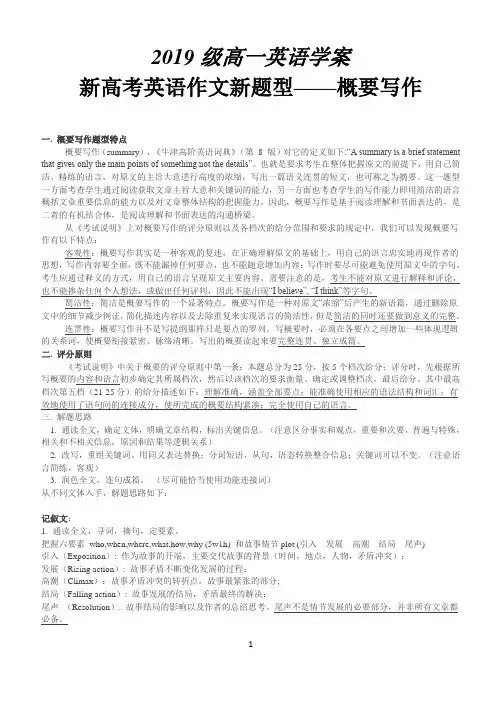
2019级高一英语学案新高考英语作文新题型——概要写作一. 概要写作题型特点概要写作(summary),《牛津高阶英语词典》(第8 版)对它的定义如下:“A summary is a brief statement that gives only the main points of something not the details”。
也就是要求考生在整体把握原文的前提下,用自己简洁、精练的语言,对原文的主旨大意进行高度的浓缩,写出一篇语义连贯的短文,也可称之为摘要。
这一题型一方面考查学生通过阅读获取文章主旨大意和关键词的能力,另一方面也考查学生的写作能力即用简洁的语言概括文章重要信息的能力以及对文章整体结构的把握能力。
因此,概要写作是基于阅读理解和书面表达的,是二者的有机结合体,是阅读理解和书面表达的沟通桥梁。
从《考试说明》上对概要写作的评分原则以及各档次的给分范围和要求的规定中,我们可以发现概要写作有以下特点:客观性:概要写作其实是一种客观的复述,在正确理解原文的基础上,用自己的语言忠实地再现作者的思想,写作内容要全面,既不能漏掉任何要点,也不能随意增加内容;写作时要尽可能避免使用原文中的字句。
考生应通过释义的方式,用自己的语言呈现原文主要内容。
需要注意的是,考生不能对原文进行解释和评论,也不能掺杂任何个人想法,或做出任何评判,因此不能出现“I believe”, “I think”等字句。
简洁性:简洁是概要写作的一个显著特点。
概要写作是一种对原文“浓缩”后产生的新语篇,通过删除原文中的细节减少例证,简化描述内容以及去除重复来实现语言的简洁性,但是简洁的同时还要做到意义的完整。
连贯性:概要写作并不是写提纲那样只是要点的罗列。
写概要时,必须在各要点之间增加一些体现逻辑的关系词,使概要衔接紧密、脉络清晰。
写出的概要读起来要完整连贯、独立成篇。
二. 评分原则《考试说明》中关于概要的评分原则中第一条:本题总分为25分,按5个档次给分;评分时,先根据所写概要的内容和语言初步确定其所属档次,然后以该档次的要求衡量、确定或调整档次,最后给分。
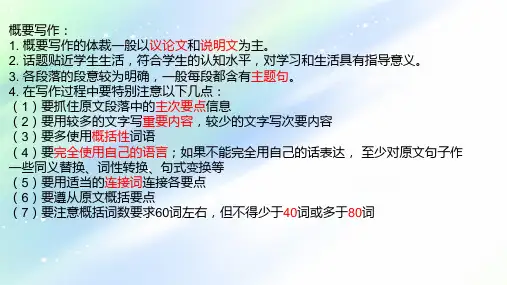
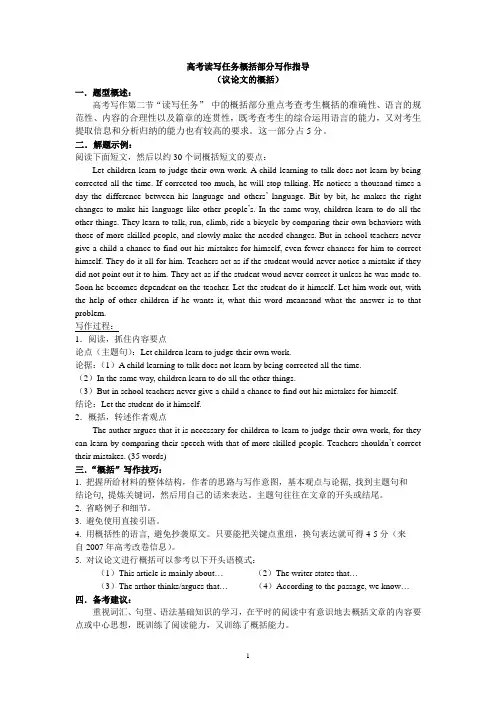
高考读写任务概括部分写作指导(议论文的概括)一.题型概述:高考写作第二节“读写任务”中的概括部分重点考查考生概括的准确性、语言的规范性、内容的合理性以及篇章的连贯性,既考查考生的综合运用语言的能力,又对考生提取信息和分析归纳的能力也有较高的要求。
这一部分占5分。
二.解题示例:阅读下面短文,然后以约30个词概括短文的要点:Let children learn to judge their own work. A child learning to talk does not learn by being corrected all the time. If corrected too much, he will stop talking. He notices a thousand times a day the difference between his language and others’language. Bit by bit, he makes the right changes to make his language like other people’s. In the same way, children learn to do all the other things. They learn to talk, run, climb, ride a bicycle by comparing their own behaviors with those of more skilled people, and slowly make the needed changes. But in school teachers never give a child a chance to find out his mistakes for himself, even fewer chances for him to correct himself. They do it all for him. Teachers act as if the student would never notice a mistake if they did not point out it to him. They act as if the student woud never correct it unless he was made to. Soon he becomes dependent on the teacher. Let the student do it himself. Let him work out, with the help of other children if he wants it, what this word meansand what the answer is to that problem.写作过程:1.阅读,抓住内容要点论点(主题句):Let children learn to judge their own work.论据:(1)A child learning to talk does not learn by being corrected all the time.(2)In the same way, children learn to do all the other things.(3)But in school teachers never give a child a chance to find out his mistakes for himself.结论:Let the student do it himself.2.概括,转述作者观点The auther argues that it is necessary for children to learn to judge their own work, for they can learn by comparing their speech with that of more skilled people. Teachers shouldn’t correct their mistakes. (35 words)三.“概括”写作技巧:1. 把握所给材料的整体结构,作者的思路与写作意图,基本观点与论据, 找到主题句和结论句, 提炼关键词,然后用自己的话来表达。
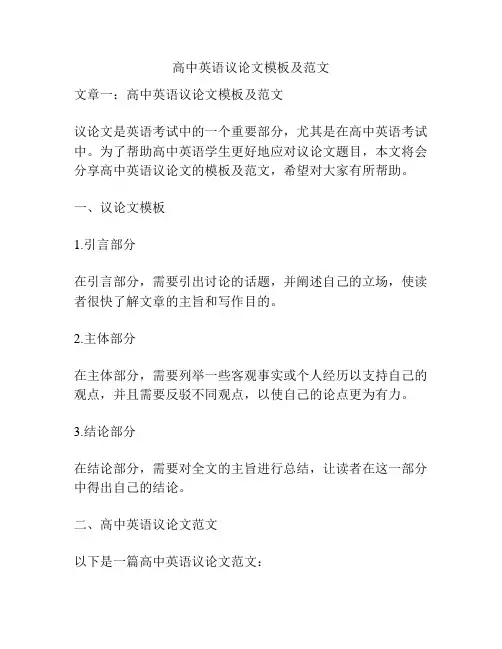
高中英语议论文模板及范文文章一:高中英语议论文模板及范文议论文是英语考试中的一个重要部分,尤其是在高中英语考试中。
为了帮助高中英语学生更好地应对议论文题目,本文将会分享高中英语议论文的模板及范文,希望对大家有所帮助。
一、议论文模板1.引言部分在引言部分,需要引出讨论的话题,并阐述自己的立场,使读者很快了解文章的主旨和写作目的。
2.主体部分在主体部分,需要列举一些客观事实或个人经历以支持自己的观点,并且需要反驳不同观点,以使自己的论点更为有力。
3.结论部分在结论部分,需要对全文的主旨进行总结,让读者在这一部分中得出自己的结论。
二、高中英语议论文范文以下是一篇高中英语议论文范文:话题:网络是否让青少年变得孤独?IntroductionNowadays, more and more young people are spending a lot of time on the Internet, and the issue of whether the Internet is making teenagers more lonely has aroused widespread concern.Main bodyOn the one hand, the Internet provides teenagers with a convenient way to communicate with their friends or meet new people. Social media and live stream platforms allow teenagers to share their lives with others, and this sense of connection can reduce their feeling of loneliness. However, on the other hand, the Internet can also be a double-edged sword. Many teenagers can become addicted to online games and social media which could leave them feeling isolated in real life. In addition, excessive use of the Internet will bring physical problems, such as nearsightedness, obesity, and fatigue, which make teenagers unwilling to go out, talk to others and participate in activities.Moreover, research shows that direct communication is far more effective than online communication. Real human interaction can relieve stress and increase happiness. However, teenagers who only communicate through the Internet are not able to enjoy the benefits of communicating with people face to face. As a result, they are more likely to feel lonely and isolated.ConclusionWhile the Internet provides young people with a convenient way to communicate, it also brings many problems such as addiction, physical problems, and losing the benefits of direct communication. Therefore, teenagers should spend less time on the Internet, learnto communicate face to face, and participate in more outdoor activities to reduce the feeling of loneliness.Main Body (continued)Furthermore, the internet can create a sense of false reality which doesn't always correlate with real life. Teenagers can start comparing their real life with the seemingly "perfect" and "amazing" lifestyles portrayed on social media. This can create feelings of inadequacy, low self-esteem, and ultimately, loneliness.A study done by the American Association of Pediatrics found that teenage girls who spend long hours on social media have higher chances of developing anxiety, depression, and poor sleep quality.Additionally, teenagers today are less likely to participate in activities outside of screens. With the vast amount of entertainment available in the virtual world, physical activities take a backseat. However, sports and outdoor activities provide teens with opportunities to interact and bond with their peers, improving their social skills and decreasing their chances of loneliness. Research has shown that spending just twenty minutes outdoors every day greatly improves mood and well-being, and can provide an excellent opportunity for real-life social interactions.Counterarguments suggest that the internet provides a platform for people to find like-minded individuals with common interests and connect with them, thereby reducing feelings of loneliness.However, while this is true, it neglects the fact that these connections are virtual and not as tangible as real life. Connecting with people online is not the same as establishing strong bonds in real life.ConclusionIn conclusion, the internet does play a role in making teenagers isolated and lonely in multiple ways. Social media and online games may provide temporary relief from boredom, but can lead to addiction, obesity, and anxiety in the long run. Furthermore, the internet can create unrealistic expectations and negatively affect self-esteem. While it is difficult to restrict internet access completely, prioritizing face-to-face communication, participating in outdoor activities, and limiting screen time can significantly reduce the feeling of loneliness. Teenagers must learn to use technology in moderation and find a balance between virtual and real-life connections for their mental and physical well-being in both the present and the future.The internet has become an integral part of our daily lives, especially for teenagers who have grown up in a digital era. However, the excessive use of technology, particularly social media and online gaming, can lead to feelings of loneliness and isolation. These virtual platforms may provide temporary relief from boredom, but they can also result in addiction, obesity, anxiety, and poor sleep quality. Additionally, the internet can create an unrealistic sense of reality, leading to low self-esteem, depression, and a sense of inadequacy. Furthermore, teenagers today are less likely to participate in activities outside of screens, which can further contribute tofeelings of isolation. Real-life social interaction through sports and outdoor activities can greatly improve mood and well-being, as well as provide opportunities to bond with peers.It is important to recognize that the internet can provide a platform for like-minded individuals to connect, but these connections are not as tangible as real-life relationships. It is crucial for teenagers to learn to use technology in moderation, prioritize face-to-face communication, participate in outdoor activities, and limit screen time. Finding a balance between virtual and real-life connections is essential for their physical and mental well-being in both the present and the future.。
高考英语议论文高考英语议论文(For and Against the College Entrance Examination)Introduction:The college entrance examination, also known as the "Gaokao" in China, is a nationwide standardized test that is taken by Chinese high school students in their final year. It is considered one of the most significant exams in China, as it determines a student's future academic and career prospects. However, there is an ongoing debate about the merits and flaws of the college entrance examination.For the College Entrance Examination:1. Fairness: The college entrance examination provides an equal opportunity for all students to compete for college admission. It is a standardized test that assesses students' knowledge and skills, regardless of their background or social status. This ensures that students are judged solely on their abilities rather than other factors, such as their family background or connections.2. Meritocracy: The college entrance examination promotes a meritocratic system where students are rewarded based on their academic performance and abilities. It encourages hard work, dedication, and competitiveness among students. Those who excel in the exam have a higher chance of obtaining admission to prestigious universities and securing better career prospects,creating a motivated and competitive atmosphere.3. University Selection: The college entrance examination simplifies the university selection process for both students and universities. With one standardized exam, universities can select students based on their performance and match them with the appropriate academic programs. It also allows students to choose the most suitable university and program based on their exam results, ensuring a better fit between students and universities.Against the College Entrance Examination:1. Exam-Centric Education: The focus on the college entrance examination leads to an exam-centric education system, where students are solely focused on achieving high scores rather than gaining a comprehensive education. This can result in a lack of creativity, critical thinking, and practical skills among students. The emphasis on memorization and rote learning restricts students' intellectual growth and limits their ability to think independently.2. Pressure and Mental Health: The college entrance examination creates immense pressure on students, often leading to high levels of stress and mental health issues. The intense competition, parental expectations, and the fear of failure can have detrimental effects on students' well-being. Some students even resort to extreme measures, such as cheating or suicide, due to the overwhelming pressure they face.3. Inequality: Despite its aim to create equal opportunities, the college entrance examination widens the gap between studentsfrom different socioeconomic backgrounds. Students from affluent families often have access to better resources, tutoring, and support, giving them an unfair advantage over their peers. This perpetuates inequality and hinders social mobility.Conclusion:The college entrance examination has both positive and negative aspects that need to be considered. While it ensures fairness and promotes a meritocratic system, it also contributes to an exam-centric education, places immense pressure on students, and perpetuates inequality. To address these concerns, reforms should be implemented to foster a more well-rounded education system that focuses on individual growth and development, while still providing equal opportunities for all students.。
高考英语规范议论文的写作思路一议论文的写作步骤:1. 引言(introduction).由于英语作文受时间、字数的限制.因此,审清题意之后在引言段中作者就必须简单解释要讨论的问题,并明白地亮出自己的观点,如提倡什么,支持什么,反对什么.2. 主体段(main body).主体段是议论的过程,作者必须有足够的证据(adequate proofs)来论证自己的观点.一般可提出两个或三个proofs, 并对此用一两句话分别进行阐述.3. 结论(conclusion).结论段可以用一两句话来结束文章.同时要注意与引言段呼应,但不能照搬前面的原话.二议论文的类型:①“一分为二”的观点.从两方面去分析一个问题,然后阐述自己的观点.②“两者选一”的观点.分析两种事物的优劣势,阐述自己的观点.③“我认为……”型.阐述对某一事物的客观看法. 如你对课外阅读的看法等鉴于高考英语作文的字数限制,建议同学们在写作时避免一分为二的写作模式。
直接采用两者选一的观点进行写作。
一) “一分为二”观点的议论文模式请看下例:Introduction第1段:Nowadays more and more people.../...plays an important part in.... Like everything else,...has/have both favorable and unfavorable aspects/ both advantages and disadvantages. Generally, the favorable aspects/advantages can be listed as follows.Main body第2段:Firstly,.. Secon dly,…In addition/What’s more…第3段: Every coin has two sides. The negative aspects/disadvantages are also apparent/obvious. To begin with…; To make matters worse…; Worse of all…Conclusion第4段: Through above analysis/All things considered, we can see that the positive aspects/advantages outweigh the negative ones/disadvantages. Therefore…“一分为二”类作文范例广告(about advertisement).提示:有人说广告在现代社会是很重要,有人认为广告的促销成分太多,你认为……二) “两者选一”观点的议论文模式模式⑴:A、B两者优劣势分析,要么选A,要么选B.请看下例:Introduction第1段:Some people hold the opinion that (A) is superior to (B) in many ways. Others, however, argue that (B) is much better. Personally, I would prefer (A) because I think (A) has more advantages.Main body第2段:There are many reasons why I prefer (A). The main reason is that …第3段:Another reason is that…(赞同A的原因)Conclusion第4段: To conclude, , (A) is much better than (B). from what has been discussed above, we may finally draw the conclusion that …(总结观点)模式⑵: A、B优势相当,依情况而定,有条件地选择A或B.Introduction第1段:Which would you prefer if you are faced with the choice between (A) and (B)? Before you make the decision, you had better make a close comparison.Main body第2段:It is true that(选择A的优势之一). It is also true that(选择A的优势之二). But (选择A的劣势).第3段: Though.(选择B的劣势), (选择B的优势之一). Furthermore, (选择B的优势之二).Conclusion第4段: Therefore, if you…, you should choose (A), but if you…, you should choose (B). (总结观点,提出建议) “两者选一”类作文范例①健康与财富(Health and Wealth)提示: 健康与财富哪个更重要一直是一个热门话题(hot topic),请简述你的观点.②哪里住更好(Where to live?)提示: 有的人喜欢往城里挤,有的人喜欢往乡下搬. 各有所好,孰是孰非,你以为如何?三.议论文的写作要点:总起:Different people hold different opinions.Opinions on …vary from person to person./differ sharply.People have taken/adopted different attitudes towards …People have different opinions/ views on this problem.表达不同观点:…of them hold the opinion that ….…of them are in favor of the idea that…People who are for/against the idea think …Some people believe that…. Others argue that …不同观点之间的衔接:However, …of them hold a different view. / …of them hold the opposite opinion.Peo ple who are against it don’t think so.However, each coin has two sides.Different from those…., …people think ….On the other hand, … people object that ….比较、对比:like, unlike, on the contrary, on the other hand…要想使文章有整体性、连贯性,就要学会正确使用连接词表示罗列增加Firs t,…. Second,…Third,…Firstly, …. Secondly, …. Thirdly, ….First of all / In the first place / To begin with,/ Above allFurthermore, / Moreover,/ In addition, / BesidesFinally, / Last but not least, / My final point is that …表示转折关系but, however, while, though, or, otherwise, on the contrary, on the other hand, in contrast, despite, in spite of, even though, except (for), instead, of course, after all,表示并列关系or, and, also, too, not only … but also, as well as, both… and, either …or, neither …nor表示因果关系because, because of, since, now that, as, thanks to…, due to…, therefore, a s a result (of), otherwise, so…that, such…that表示条件关系as (so) long as, on condition that, if, unless表示让步关系though, although, as, even if, even though, whether …or…, however, whoever, whatever, whichever, wherever, whenever, no matter how (who, what, which, where, when, whom)表示举例for example, for instance, such as…, take… for example表示比较be similar to, similarly, the same as, in contrast(对比而言), compared with (to)…just like, just as,表示目的for this reason, for this purpose, so that, in order to, so as to,表示强调indeed, in fact, surely, certainly, There is no doubt that, without any doubt, truly, obviously, above all,表示概括归纳In a word, In short, In brief, On the whole, Generally speaking, As we all know, As has been stated, As I have shown, In summary,In conclusion, As mentioned above, we can come to the conclusion tha t…Sentences:1.Through above analysis, we can see that the positive aspects outweigh the negative ones. Therefore, I am infavor of doing sth.2.These activities can serve as a bridge between theory and practice.3.The following are the reasons of my viewpoint.4.The same is true of English listening and writing.…也一样适用5.To sum up, I maintain that …6.There is a great deal to be said in favour of advertisements.7.From the above analysis, we can arrive at a conclusion that…8.We can not ignore the significance of sth 不能忽视某事物的重要性9.Some people hold the opinion that ….Others, however, argue that ….Personally, I would prefer …10.The answer is certainly negative.11.Perseverance is what really counts in doing anything.12.From what has been discussed above, we may finally draw the conclusion that。
上海高考英语新题型之概要写作(Summary)上海高考英语新题型之概要写作澄衷高级中学孙吉从2017年起,上海英语高考试卷的题型将面临许多调整,其中之一便是增加了概要写作(Summary writing),也有许多人将之称为小作文”概要写作分值占据15分,考查的是考生阅读和写作的综合能力。
概要写作所给定的语篇一般在200-250字,内容丰富多样,包含故事、时政、科普等,体裁以记叙文、说明文为主,字数一般要求在50-60字,答案尽量符合“ Key poi nts of a summary勺要求。
一?正确认识概要写作1. Defin iti on of summary writ ing (概要写作的定义)By summary, we mean a brief restatement, in your own words, of the content of a passage, an article, a chapter or a book.2. Key poi nts of a summary (概要写作的要点)Conciseness(简要性):Omit unnecessary details like examples, explanations and other uni mporta nt in formati on.Length: 1/4-1/3 of the original text.Completeness (完整性):To include all the main and supporting points delivered in you own words in a conden sed manner.Accuracy (准确性):To give the same attention and stress to the points as the author does.Cohere nee (连贯性):Rather tha n an outl ine listed as key words and phrases, a summary is a paragraph with n ecessary tran siti ons and fun cti on structures to make it flow.Objectivity (客观性):Do not include your own ideas or emotions on the topic.The summary should reflect the content of the origi nalpassage only.3. Steps to write a summary (概要写作的步骤)1)Skim the text to find out the general theme.2)An alyze the text ' s structure to divide it into several sect ions, find out the main idea of each sect ion and write it out briefly with your own words. (one senten ce)3)Write down the key supporting points for each main idea without involving minor details.4)Organize the main and related supporting points in a logical order with necessary tran siti ons to achieve cohere nee.5)Proofread for grammatical, spelling and punctuation mistakes.4. Beginning of a summary (概要写作的开头)Beg in your summary with:*The author ' s name*The article ' s or chapter ' s name*The author ' s thesis statement —a general overview (survey) of the article.The Body:First of all, the author describes .....He then points out that ...............In addition, the author talks about .....Finally, the author suggests .....Some other in troductory phrases:*(The author) states in (this article) that …*(The author), in (this article) shows that …*ln (this article), (the author) writes that …*As (t he author) says in (this article), …*The main idea of (the author ' s article) is …*The author believes (holds; maintains; claims; argues; pointsout; suggests; proposes) that +clause …*The author talks about (expla ins; describes; reveals; discusses; focuses on) + n.二?记叙文概要写作要点点拨记叙文体的阅读材料,相比其他文体而言,写概要相对容易。
高考英语议论文作文As the high school entrance examination is approaching, the pressure on students is increasing. Many people believe that the exam is a crucial factor in determining astudent's future. However, some argue that it is not a fair way to evaluate students. Personally, I think the exam is just a part of the evaluation and should not be the only standard for students' future.The high school entrance examination is indeed a significant event for students. It can determine which school they will attend and even their future career. Therefore, it is natural for students to feel stressed and anxious about the exam. However, it is important to remember that the exam is not the only factor that determines a student's future. There are many other aspects of a student's abilities and potential that should be taken into consideration.Some people argue that the high school entranceexamination is not a fair way to evaluate students. They believe that the exam puts too much pressure on students and does not accurately reflect their abilities. While it is true that the exam can be stressful, it is also a way to measure a student's academic performance. Moreover, the exam is just one part of the evaluation process. Schools also consider students' extracurricular activities, personal qualities, and potential when making admissions decisions.In conclusion, while the high school entrance examination is an important event for students, it should not be the only factor that determines their future. It is important to remember that there are many other aspects of a student's abilities and potential that should be taken into consideration. Therefore, students should not be overly stressed about the exam and should focus on developing their overall abilities.。
英语议论文作文模板高考Title: English Argumentative Essay Template for College Entrance Examination。
In recent years, the English argumentative essay has become an important part of the college entrance examination. It requires students to analyze and evaluate a given topic, and present their own opinions and arguments in a clear and logical manner. In this essay, we will discuss the structure and key points of an English argumentative essay, and provide a template for students to follow.Introduction:Start with a hook to grab the reader's attention.Provide background information on the topic.State the thesis statement, which presents the main argument of the essay.Body Paragraphs:Each body paragraph should focus on a separate point that supports the thesis statement.Start with a topic sentence that introduces the main idea of the paragraph.Provide evidence, such as facts, statistics, or examples, to support the point.Analyze the evidence and explain how it relates to the main argument.Use transition words and phrases to connect the paragraphs and create a smooth flow of ideas.Counterargument:Acknowledge the opposing viewpoint on the topic.Refute the counterargument with evidence and reasoning.Explain why the main argument is stronger and more convincing.Conclusion:Summarize the main points of the essay.Restate the thesis statement and reinforce the main argument.End with a strong closing statement that leaves a lasting impression on the reader.Template:Introduction:Hook: Start with a thought-provoking question, quote, or anecdote related to the topic.Background: Provide a brief overview of the issue or topic being discussed.Thesis statement: Clearly state the main argument of the essay and the key points that will be addressed.Body Paragraphs:Topic sentence: Introduce the main idea of the paragraph.Evidence: Provide specific examples, statistics, or expert opinions to support the point.Analysis: Explain how the evidence supports the main argument and why it is relevant.Transition: Use transition words and phrases to connect the paragraphs and maintain a logical flow of ideas.Counterargument:Acknowledge the opposing viewpoint and briefly explain it.Refutation: Present evidence and reasoning to refute the counterargument.Explanation: Explain why the main argument is more valid and persuasive.Conclusion:Summary: Recap the main points discussed in the essay.Restate thesis: Repeat the main argument and its significance.Closing statement: End with a powerful statement that reinforces the main argument and leaves a lasting impression.In conclusion, the English argumentative essay is an important component of the college entrance examination. By following the structure and key points outlined in this template, students can effectively present their opinions and arguments in a clear and persuasive manner. Mastering the art of writing a compelling argumentative essay will not only help students succeed in their college entrance examinations but also equip them with essential critical thinking and communication skills for the future.。